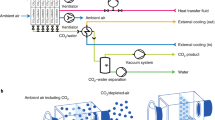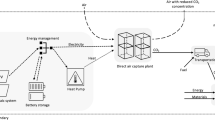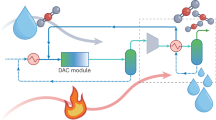Abstract
Direct air capture (DAC) technologies remove carbon dioxide (CO2) from ambient air through chemical sorbents. Their scale-up is a backstop in many climate policy scenarios, but their environmental implications are debated. Here we present a comparative life-cycle assessment of two main DAC technologies coupled with carbon storage: temperature swing adsorption (TSA) and high-temperature aqueous solution (HT-Aq) DAC. Our results show that TSA DAC outperforms HT-Aq DAC by a factor of 1.3–10 in all environmental impact categories studied. With a low-carbon energy supply, HT-Aq and TSA DAC have a net carbon removal of up to 73% and 86% per ton of CO2 captured and stored. For the same climate change mitigation effect, TSA DAC needs about as much renewable energy and land occupation as a switch from gasoline to electric vehicles, but with approximately five times higher material consumption. Input requirements for chemical absorbents do not limit DAC scale-up.
This is a preview of subscription content, access via your institution
Access options
Access Nature and 54 other Nature Portfolio journals
Get Nature+, our best-value online-access subscription
$29.99 / 30 days
cancel any time
Subscribe to this journal
Receive 12 digital issues and online access to articles
$119.00 per year
only $9.92 per issue
Buy this article
- Purchase on Springer Link
- Instant access to full article PDF
Prices may be subject to local taxes which are calculated during checkout




Similar content being viewed by others
Data availability
Code availability
The OpenLCA process models for different cases of HT-Aq DAC and TSA DAC are provided on Zenodo at https://doi.org/10.5281/zenodo.5500477. To rerun the LCA calculations, OpenLCA (freeware) and the Ecoinvent 3.5 database (license required) need to be installed on a standard desktop computer or laptop with at least 8 GB RAM.
References
IPCC Climate Change 2014: Synthesis Report (eds Core Writing Team, Pachauri, R. K. & Meyer, L. A.) (IPCC, 2014).
IPCC Special Report on Global Warming of 1.5 °C (eds Masson-Delmotte, V. et al.) (WMO, 2018).
Socolow, R. et al. Direct Air Capture of CO2 With Chemicals: A Technology Assessment for the APS Panel on Public Affairs (American Physical Society, 2011).
Minx, J. C. et al. Negative emissions—Part 1: research landscape and synthesis. Environ. Res. Lett. 13, 63001 (2018).
Hanna, R., Abdulla, A., Xu, Y. & Victor, D. G. Emergency deployment of direct air capture as a response to the climate crisis. Nat. Commun. 12, 368 (2021).
IPCC Special Report on Carbon Dioxide Capture and Storage (eds Metz, B. et al.) (Cambridge Univ. Press, 2005).
Wang, T., Lackner, K. S. & Wright, A. Moisture swing sorbent for carbon dioxide capture from ambient air. Environ. Sci. Technol. 45, 6670–6675 (2011).
Marcucci, A., Kypreos, S. & Panos, E. The road to achieving the long-term Paris targets: energy transition and the role of direct air capture. Climatic Change 144, 181–193 (2017).
Viebahn, P., Scholz, A. & Zelt, O. The potential role of direct air capture in the German energy research program—results of a multi-dimensional analysis. Energies 12, 3443 (2019).
Fasihi, M., Efimova, O. & Breyer, C. Techno-economic assessment of CO2 direct air capture plants. J. Clean. Prod. 224, 957–980 (2019).
Sanz-Pérez, E. S., Murdock, C. R., Didas, S. A. & Jones, C. W. Direct capture of CO2 from ambient air. Chem. Rev. 116, 11840–11876 (2016).
Salmón, I., Cambier, N. & Luis, P. CO2 capture by alkaline solution for carbonate production: a comparison between a packed column and a membrane contactor. Appl. Sci. 8, 996 (2018).
House, K. Z. et al. Economic and energetic analysis of capturing CO2 from ambient air. Proc. Natl Acad. Sci. USA 108, 20428–20433 (2011).
Fuhrman, J. et al. Food-energy-water implications of negative emissions technologies in a + 1.5 °C future. Nat. Clim. Change 10, 920–927 (2020).
Keith, D. W., Holmes, G., St. Angelo, D. & Heidel, K. A process for capturing CO2 from the atmosphere. Joule 2, 1573–1594 (2018).
Realmonte, G. et al. Reply to ‘High energy and materials requirement for direct air capture calls for further analysis and R&D’. Nat. Commun. 11, 3286 (2020).
Chatterjee, S. & Huang, K.-W. Unrealistic energy and materials requirement for direct air capture in deep mitigation pathways. Nat. Commun. 11, 3287 (2020).
de Jonge, M. M., Daemen, J., Loriaux, J. M., Steinmann, Z. J. & Huijbregts, M. A. Life cycle carbon efficiency of direct air capture systems with strong hydroxide sorbents. Int. J. Greenh. Gas Control 80, 25–31 (2019).
Liu, C. M., Sandhu, N. K., McCoy, S. T. & Bergerson, J. A. A life cycle assessment of greenhouse gas emissions from direct air capture and Fischer–Tropsch fuel production. Sustain. Energy Fuels 4, 3129–3142 (2020).
Deutz, S. & Bardow, A. Life-cycle assessment of an industrial direct air capture process based on temperature-vacuum swing adsorption. Nat. Energy 6, 203–213 (2021).
Budinis, S. Direct Air Capture (International Energy Agency, 2020).
Negative Emissions Technologies and Reliable Sequestration: a Research Agenda (National Academies Press, 2019); https://doi.org/10.17226/25259
Hertwich, E. G. et al. Integrated life-cycle assessment of electricity-supply scenarios confirms global environmental benefit of low-carbon technologies. Proc. Natl Acad. Sci. USA 112, 6277–6282 (2015).
McQueen, N. et al. Cost analysis of direct air capture and sequestration coupled to low-carbon thermal energy in the United States. Environ. Sci. Technol. 54, 7542–7551 (2020).
Bahar, H. & Bojek, P. Concentrating Solar Power (CSP) (International Energy Agency, 2020).
Sandalow, D., Friedmann, J., McCormick, C. & McCoy, S. Direct Air Capture of Carbon Dioxide (Innovation for Cool Earth Forum, 2018).
Baciocchi, R., Storti, G. & Mazzotti, M. Process design and energy requirements for the capture of carbon dioxide from air. Chem. Eng. Process. 45, 1047–1058 (2006).
Singh, B., Strømman, A. H. & Hertwich, E. G. Comparative impact assessment of CCS portfolio: life cycle perspective. Energy Procedia 4, 2486–2493 (2011).
Hanssen, S. V. et al. The climate change mitigation potential of bioenergy with carbon capture and storage. Nat. Clim. Change 10, 1023–1029 (2020).
Querini, F., Dagostino, S., Morel, S. & Rousseaux, P. Greenhouse gas emissions of electric vehicles associated with wind and photovoltaic electricity. Energy Procedia 20, 391–401 (2012).
Kätelhön, A., Meys, R., Deutz, S., Suh, S. & Bardow, A. Climate change mitigation potential of carbon capture and utilization in the chemical industry. Proc. Natl Acad. Sci. USA 116, 11187–11194 (2019).
Gibon, T., Arvesen, A. & Hertwich, E. G. Life cycle assessment demonstrates environmental co-benefits and trade-offs of low-carbon electricity supply options. Renew. Sustain Energy Rev. 76, 1283–1290 (2017).
Non-exhaust Particulate Emissions from Road Transport: An Ignored Environmental Policy Challenge (Organisation for Economic Co-operation and Development, 2020).
Heck, V., Gerten, D., Lucht, W. & Popp, A. Biomass-based negative emissions difficult to reconcile with planetary boundaries. Nat. Clim. Change 8, 151–155 (2018).
Creutzig, F. et al. Considering sustainability thresholds for BECCS in IPCC and biodiversity assessments. Glob. Change Biol. Bioenergy 13, 510–515 (2021).
Gabrielli, P., Gazzani, M. & Mazzotti, M. The role of carbon capture and utilization, carbon capture and storage, and biomass to enable a Net-Zero-CO2 emissions chemical industry. Ind. Eng. Chem. Res. 59, 7033–7045 (2020).
Davis, S. J. et al. Net-zero emissions energy systems. Science https://doi.org/10.1126/science.aas9793 (2018).
Carton, W., Lund, J. F. & Dooley, K. Undoing equivalence: rethinking carbon accounting for just carbon removal. Front. Clim. https://doi.org/10.3389/fclim.2021.664130 (2021).
Kearns, J. et al. Developing a consistent database for regional geologic CO2 storage capacity worldwide. Energy Procedia 114, 4697–4709 (2017).
Arvidsson, R. et al. Environmental assessment of emerging technologies: recommendations for prospective LCA. J. Ind. Ecol. 22, 1286–1294 (2018).
ISO 14044:2006 Umweltmanagement—Ökobilanz—Anforderungen und Anleitungen (International Organization for Standards, 2006).
ISO 14040:2006 Umweltmanagement—Ökobilanz—Grundsätze und Rahmenbedingungen (International Organization for Standards, 2006).
Direct air capture to help reverse climate change. Climeworks https://www.climeworks.com/page/co2-removal (2020).
von der Assen, N., Voll, P., Peters, M. & Bardow, A. Life cycle assessment of CO2 capture and utilization: a tutorial review. Chem. Soc. Rev. 43, 7982–7994 (2014).
Hauschild, M. Z. et al. Identifying best existing practice for characterization modeling in life cycle impact assessment. Int. J. Life Cycle Assess. 18, 683–697 (2013).
Holmes, G. et al. Outdoor prototype results for direct atmospheric capture of carbon dioxide. Energy Procedia 37, 6079–6095 (2013).
Pehnt, M. & Henkel, J. Life cycle assessment of carbon dioxide capture and storage from lignite power plants. Int. J. Greenh. Gas Control 3, 49–66 (2009).
Steubing, B., Wernet, G., Reinhard, J., Bauer, C. & Moreno-Ruiz, E. The ecoinvent database version 3 (part II): analyzing LCA results and comparison to version 2. Int. J. Life Cycle Assess. 21, 1269–1281 (2016).
Acknowledgements
K.M. was supported by a grant from the Eva Mayr-Stihl Foundation under the PROSET project. We thank G. Realmonte for providing additional references for DAC material consumption.
Author information
Authors and Affiliations
Contributions
K.M., S.P. and F.C. co-designed the research and jointly wrote the paper. S.D. compiled the process inventories for the TSA DAC plant and conducted the LCA for this technology. K.M. compiled the process inventories for the HT-Aq DAC, conducted the comparative LCA, prepared the figures and compiled the supplementary material. S.P. developed the 1 Gt scale-up comparison with other technology pathways.
Corresponding author
Ethics declarations
Competing interests
The authors declare no competing interests.
Additional information
Peer review information Nature Energy thanks Derrick Carlson and the other, anonymous, reviewer(s) for their contribution to the peer review of this work.
Publisher’s note Springer Nature remains neutral with regard to jurisdictional claims in published maps and institutional affiliations.
Supplementary information
Supplementary Information
Supplementary Notes 1–5, Figs. 1–11, Discussion and Tables 1–7.
Supplementary Data 1
Ancillary calculations and numerical values for HT-Aq DAC.
Supplementary Data 2
Ancillary calculations and numerical values for TSA DAC.
Supplementary Data 3
Ancillary calculations and numerical values shown in plots and Table 3.
Rights and permissions
Springer Nature or its licensor (e.g. a society or other partner) holds exclusive rights to this article under a publishing agreement with the author(s) or other rightsholder(s); author self-archiving of the accepted manuscript version of this article is solely governed by the terms of such publishing agreement and applicable law.
About this article
Cite this article
Madhu, K., Pauliuk, S., Dhathri, S. et al. Understanding environmental trade-offs and resource demand of direct air capture technologies through comparative life-cycle assessment. Nat Energy 6, 1035–1044 (2021). https://doi.org/10.1038/s41560-021-00922-6
Received:
Accepted:
Published:
Issue Date:
DOI: https://doi.org/10.1038/s41560-021-00922-6
This article is cited by
-
The refinery of the future
Nature (2024)
-
Impact of global heterogeneity of renewable energy supply on heavy industrial production and green value chains
Nature Energy (2024)
-
A taxonomy to map evidence on the co-benefits, challenges, and limits of carbon dioxide removal
Communications Earth & Environment (2024)
-
Co-assessment of costs and environmental impacts for off-grid direct air carbon capture and storage systems
Communications Engineering (2024)
-
A differential game approach to the low-carbon chains considering the role of shareholding
Environment, Development and Sustainability (2024)



